|
Innovation in Glass
by Bob Brooke
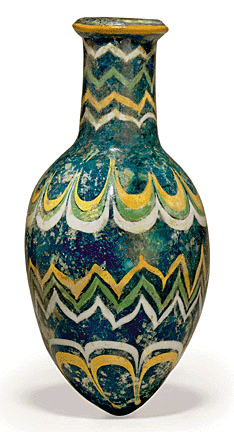 Glass,
especially functional and decorative glass vessels, was a part of
everyday life in the Roman Empire. Artisans experimented with
glass-making techniques and applied innovation to take the art of
glass-making even further. Glass shifted from a luxury item to everyday
object, yet retained its decadence. Glass,
especially functional and decorative glass vessels, was a part of
everyday life in the Roman Empire. Artisans experimented with
glass-making techniques and applied innovation to take the art of
glass-making even further. Glass shifted from a luxury item to everyday
object, yet retained its decadence.
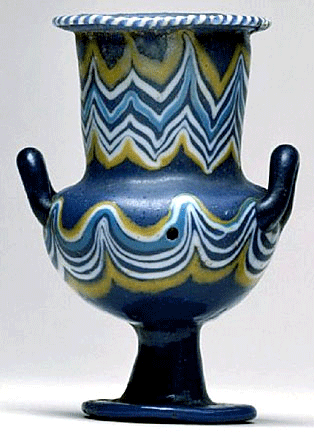 Man
first made glass by combining silica, or sand quartz, soda ash, and line
with fire around 3500 BCE in Mesopotamia. The Phoenicians further
developed the craft that eventually spread from the Near East to Egypt
and the Mediterranean. Man
first made glass by combining silica, or sand quartz, soda ash, and line
with fire around 3500 BCE in Mesopotamia. The Phoenicians further
developed the craft that eventually spread from the Near East to Egypt
and the Mediterranean.
The Egyptians produced decorative glass objects such as vases, bottles,
beakers, and beads. During the Hellenistic period, glass was a luxury
item and only the wealthy could afford it. The Romans later drew
inspiration from Hellenistic glass makers, taking the craft even further
following the invention of glassblowing.
Glassblowing Transforms the Process
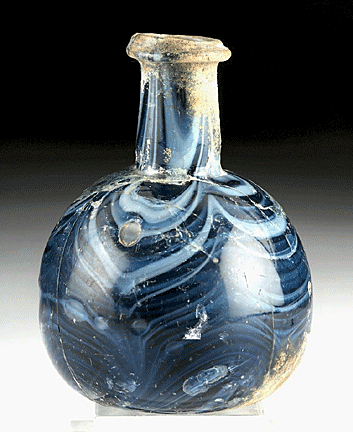 The
Phoenicians invented glassblowing. But it was the Romans who created
innovative glass objects using it. They discovered that glassblowing was
a more flexible and efficient technique that took less time to produce
quality glass objects. The
Phoenicians invented glassblowing. But it was the Romans who created
innovative glass objects using it. They discovered that glassblowing was
a more flexible and efficient technique that took less time to produce
quality glass objects.
Roman glass workers worked with an array of different colors and
patterns. Marbled glass imitated the patterns found in natural stones.
Lace, striped and spiral patterns were also popular in glass vessels.
Snake thread decoration was the application of trailed glass in a
serpentine design. Glass also became more translucent during this time
and artisans were able to get more creative with their designs.
Glassblowing also led to the mass production of glass objects, making
them accessible to all classes of people. Glass jewelry was an
inexpensive alternative to precious gemstones.
Luxury Glass Vessels
 Glass
continued to be a highly valued material despite its affordability
during the Roman Empire. Only the very wealthy could afford certain
glass objects, such as cameo glass and vasa diatreta or cage cups. Cameo
glass was a decorative, multi-layered, carved glass ensemble. Figures of
gods and goddesses were popular motifs. Glass
continued to be a highly valued material despite its affordability
during the Roman Empire. Only the very wealthy could afford certain
glass objects, such as cameo glass and vasa diatreta or cage cups. Cameo
glass was a decorative, multi-layered, carved glass ensemble. Figures of
gods and goddesses were popular motifs.
Cage cups, on the other hand, were time-consuming works of art and a
staple of lavish Roman banquets. These spectacular glass goblets consist
of a glass vessel surrounded by a lattice pattern cage of glass circles.
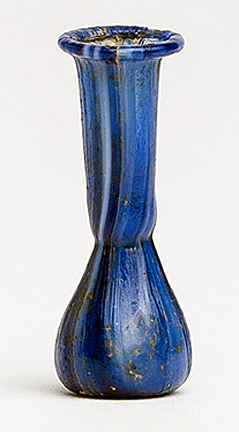 The
Lycurgus Cup was the most impressive example of this type of glass
vessel. The glass itself presents a magical transformation of color
depending on the angle of the light. It appears a hazy, jade green in
ordinary light but when lit from behind, it appears an amber red. The
most prized glass of the Roman elite was Alexandrian glass. This was a
crystal-clear, colorless glass often used to make windows. The
Lycurgus Cup was the most impressive example of this type of glass
vessel. The glass itself presents a magical transformation of color
depending on the angle of the light. It appears a hazy, jade green in
ordinary light but when lit from behind, it appears an amber red. The
most prized glass of the Roman elite was Alexandrian glass. This was a
crystal-clear, colorless glass often used to make windows.
 Roman
glassmakers created several types of glass objects from everyday
dinnerware to unique vessels. Perhaps the most unique were the ”tear
bottles” or lachrymatory. These small glass vessels were symbolic and
stored the tears of mourners who lost a loved one. The more tears saved
proved how deeply someone felt for the lost or deceased. Many of these
Roman tear bottles have been discovered in tombs. Roman
glassmakers created several types of glass objects from everyday
dinnerware to unique vessels. Perhaps the most unique were the ”tear
bottles” or lachrymatory. These small glass vessels were symbolic and
stored the tears of mourners who lost a loved one. The more tears saved
proved how deeply someone felt for the lost or deceased. Many of these
Roman tear bottles have been discovered in tombs.
Flasks in the shape of animals were another creative design of glass
vessels. The ancient Romans revered animal symbolism, and nature
inspired many Roman artisans. Fruits also served as inspiration. Head
flasks, inspired by mythological figures or the gods, were another
popular design.
The Roman Glass Process
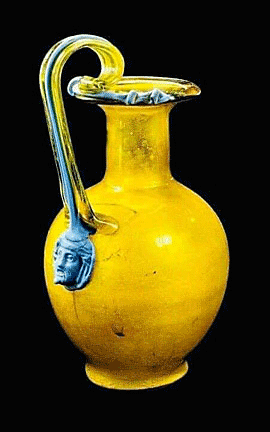 Roman
glass makers melted down the raw materials to make glass. Once the glass
cooled and hardened, they broke it down into pieces to be transported
throughout the Mediterranean region. This material was then sent to
glass workers who re-melted the glass back to its liquid state to make a
variety of glass objects. These glass makers and workers were anonymous
laborers who played an important role in the Roman glass industry. Roman
glass makers melted down the raw materials to make glass. Once the glass
cooled and hardened, they broke it down into pieces to be transported
throughout the Mediterranean region. This material was then sent to
glass workers who re-melted the glass back to its liquid state to make a
variety of glass objects. These glass makers and workers were anonymous
laborers who played an important role in the Roman glass industry.
Before glassblowing, the manufacture of glass was a slow and complicated
process, and, consequently, glassware was a luxury item available only
to the wealthy. With the development of glassblowing, however,
production became quicker and easier, costs went down, and a much
broader swath of the population could afford to purchase glassworks.
The process of glassblowing consists of placing a glob of molten glass
on one end of a long metal tube known as a blowpipe and then blowing
through the pipe to inflate the glass. In the method of glassblowing
known as mold-blowing, the molten glass is inflated inside a prepared
mold, and the glass then takes on the form of that mold, as well as any
decoration carved inside the mold.
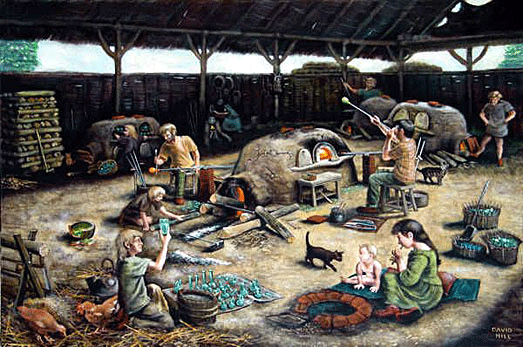
 Though
the glassblowing technique made glass vessels less expensive, it didn’t
make them all equal. Some glasswares continued to be produced,
particularly those displaying the intricate carving of cameo decoration.
Other luxury wares included those with mosaic decoration and those that
incorporated gold leaf between layers of glass. Though
the glassblowing technique made glass vessels less expensive, it didn’t
make them all equal. Some glasswares continued to be produced,
particularly those displaying the intricate carving of cameo decoration.
Other luxury wares included those with mosaic decoration and those that
incorporated gold leaf between layers of glass.
Unfortunately, the addition of handles on glass vessels invariably
marred them. But some glassmakers were adept at attaching handles to
produce some exquisite pieces.
Ancient Roman glassworkers were able to produce wares in an impressive
array of hues. They created color in glass by adding metallic oxides to
the glass mixture or by controlling the amount of oxygen in the furnace
during the glassmaking process. The mismatched colors of the handles and
bodies of some Roman glasswares indicated that glassworkers used
whatever scraps they had available.
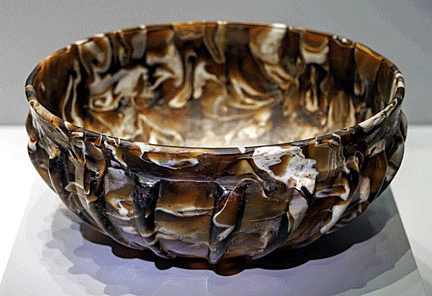
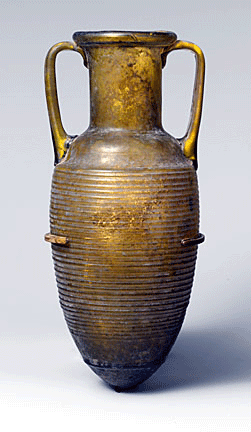 Sometimes,
Roman glassmakers produced vessels in a variety of colors that were
related to the contents inside, such as the amphoriskos, a small
two-handled amphora used to hold perfume. Historians believe that a
bottle’s colors indicated its contents. For example, a floral fragrance
might have been kept in an amphoriskos of one color, while a different
color might have designated a spicy or fruity scent. Sometimes,
Roman glassmakers produced vessels in a variety of colors that were
related to the contents inside, such as the amphoriskos, a small
two-handled amphora used to hold perfume. Historians believe that a
bottle’s colors indicated its contents. For example, a floral fragrance
might have been kept in an amphoriskos of one color, while a different
color might have designated a spicy or fruity scent.
Glass was a popular material for all sorts of vessels, including oil
lamps, cosmetic and jewelry boxes, storage and transport containers,
perfume bottles, ointment pots, and wine jugs and cups. Glass vessels
were, in fact, such an integral part of daily life in the Roman Empire
that glassmakers produced 100 million of them annually.
<
More Special Features Next
Article >
|
